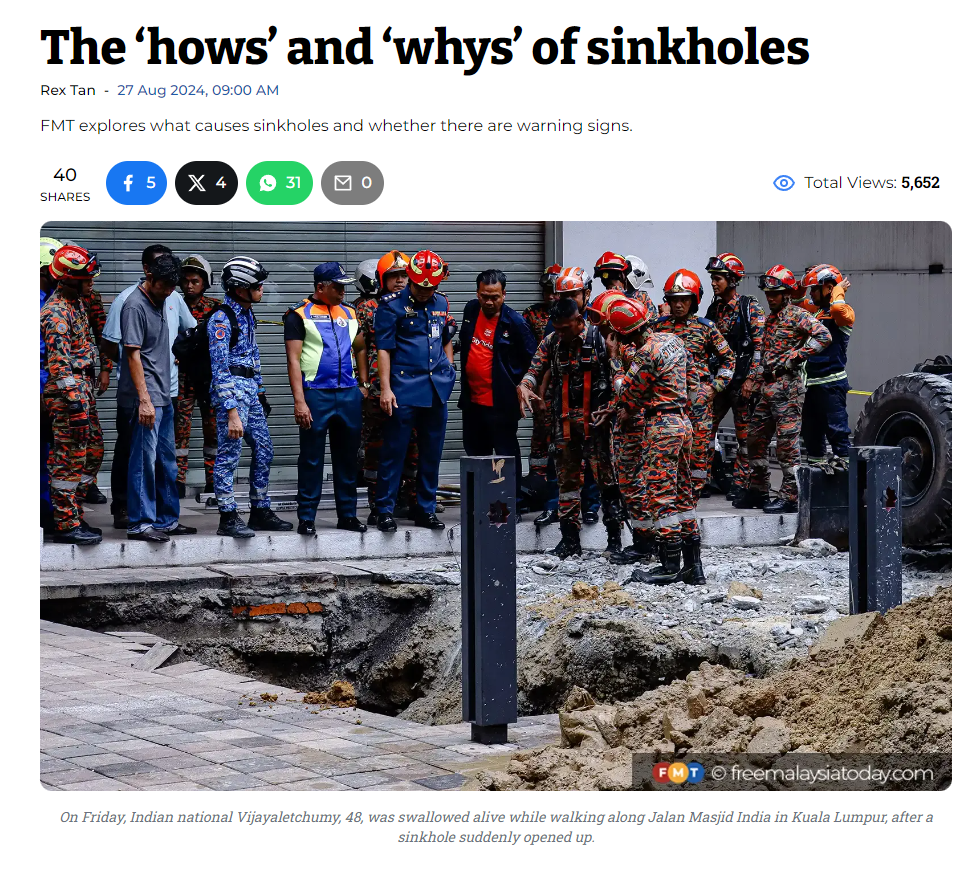
The victim, identified as Vijayaletchumy, 48, had been walking on a concrete path outside Malayan Mansion when an 8m-deep sinkhole suddenly opened up and swallowed her alive.
Relentless search and rescue efforts have followed but the victim has yet to be found. Meanwhile, a wastewater expert has expressed fears that the victim is unlikely to have survived the high speeds at which water flows along the sewer lines.
How do sinkholes occur?
Sinkholes occur when an underground area can no longer accommodate the weight of its surface terrain. Simply put, these cave-ins are caused by erosion occurring beneath ground level.
This phenomenon usually takes place in areas where the surface rock comprises limestone or other forms of carbonate rock, salt beds and other materials capable of being naturally dissolved by groundwater.
As flowing water slowly chips away at subterranean foundations and destabilises the bedrock, hidden new caves emerge. These may collapse, creating sinkholes.
Natural and human factors
Underground erosion may arise both naturally or as a result of human activity.
The movement of water is a ubiquitous natural force in our world. It not only shapes landscapes visible to us, such as karst pinnacles and sea stacks, but also creates hidden underground rivers and caves.
Limestone terrains are particularly vulnerable to water erosion. Rainfall absorbs carbon dioxide from the soil before converging with the underground water, turning it slightly acidic.
This waterflow erodes the limestone sub-terrain and creates a network of cavities and voids. The US state of Florida, which has a geographical terrain primarily composed of limestone, is particularly prone to cave-ins.
Many sinkhole accidents are also attributable to rapid urbanisation.
For example, drought and high groundwater withdrawals may reduce the buoyancy of an area and trigger the sinking of sub-terrain areas into cavities. Similarly, changes to groundwater composition due to the introduction or removal of waterflows may flush out looser materials and precipitate sinkholes.
Faulty underground water pipes may also give rise to deadly urban sinkholes. Even a slight gap between these pipes is capable of introducing a large amount of water into adjacent soil, dislodging and eventually causing the subsurface to become unstable.
Despite the growth of cavities beneath the ground, no obvious signs of instability tend to appear above it.
With many of our utility pipes placed directly below ground, the paving of roads and pathways often acts as a bridge above sinkholes, hiding insidious voids below.
If a cavity is not discovered and resolved in time, the surface is likely to eventually give way and swallow everything above ground.
Early detection?
Although the existence of sinkholes underground is usually not apparent, several subtle signs may hint at a possible collapse of the sub-terrain.
Cracks in a foundation, an inability to close doors and windows properly, and the appearance of ground cracks in circular patterns are all tell-tale signs of ground instability which may point to the potential emergence of a sinkhole.
Since the tragic event on Friday, the government has advised the Kuala Lumpur City Hall (DBKL) and all utility companies to carry out a mapping of all underground utilities in an attempt to ascertain the state of the terrain below so that further untoward incidents can be avoided.
Other notable sinkhole incidents
One of the most well-known sinkhole accidents took place in Guatemala 14 years ago. On May 30, 2010, a giant sinkhole appeared without warning in Guatemala City, the Central American country’s capital.
The monstrous cavity, measuring 20m wide and 90m deep, swallowed a three-storey factory and its security guard. It was reported that the sinkhole occurred due to a combination of causes.
Subterranean stability in the area had been undermined both by natural causes in the form of a tropical cyclone and a volcanic eruption, and as a result of human activity, arising from sewer pipe leakages.
Sinkholes in natural habitats have sometimes also created astonishing natural sights.
For example, the Great Blue Hole, off the coast of Belize, has turned into a popular scuba diving destination. Recording a 300m width and 135m depth, the marine sinkhole was once a limestone cave system before the ocean rose.


